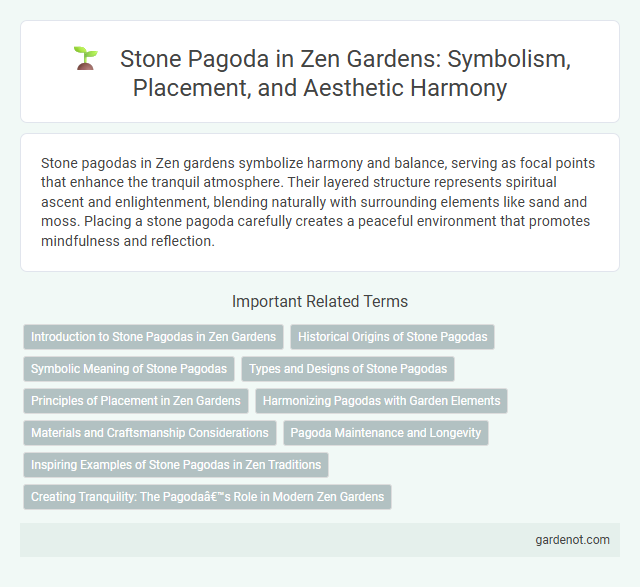Stone pagodas in Zen gardens symbolize harmony and balance, serving as focal points that enhance the tranquil atmosphere. Their layered structure represents spiritual ascent and enlightenment, blending naturally with surrounding elements like sand and moss. Placing a stone pagoda carefully creates a peaceful environment that promotes mindfulness and reflection.
Introduction to Stone Pagodas in Zen Gardens
Stone pagodas in Zen gardens symbolize spiritual harmony and balance, serving as focal points that enhance meditative ambiance. Typically constructed from stacked, weathered stones, these pagodas embody simplicity and timelessness intrinsic to Zen aesthetics. Their deliberate placement within gravel or moss landscapes reinforces principles of mindfulness and natural beauty central to Zen gardening.
Historical Origins of Stone Pagodas
Stone pagodas originated in ancient East Asia, serving as spiritual monuments rooted in Buddhist traditions. These structures reflect the transmission of Buddhist architectural styles from India to Korea and Japan during the Three Kingdoms period (circa 1st to 7th century). They symbolize enlightenment and are often incorporated into Zen gardens to evoke tranquility and historical reverence.
Symbolic Meaning of Stone Pagodas
Stone pagodas in Zen gardens embody spiritual stability and the pathway to enlightenment, representing the five elements of earth, water, fire, wind, and void in Buddhist cosmology. These layered structures symbolize a connection between the physical and spiritual worlds, fostering meditation and mindfulness. Their balanced, ascending form inspires harmony, resilience, and the pursuit of inner peace.
Types and Designs of Stone Pagodas
Stone pagodas in Zen gardens exhibit a variety of types and designs, each symbolizing different spiritual meanings and aesthetic principles. Common structures include the five-tiered hoto, representing the five elements, and the intricate gorinto, which symbolizes earth, water, fire, wind, and void. Designs range from simple, rustic stones to elaborately carved monuments, reflecting the garden's harmony and tranquility.
Principles of Placement in Zen Gardens
Stone pagodas in Zen gardens are meticulously positioned to enhance balance, harmony, and spiritual symbolism within the landscape. Their placement follows key principles such as alignment with natural elements, visual flow, and asymmetrical balance to create contemplative spaces that invite meditation. Emphasizing spatial relationships, stone pagodas serve as focal points that guide viewers' attention while maintaining serenity and simplicity in the garden's design.
Harmonizing Pagodas with Garden Elements
Stone pagodas in Zen gardens serve as focal points that harmonize with natural elements like rocks, water, and plants to create a balanced and tranquil atmosphere. Their layered, symmetrical design echoes the garden's structural rhythm, enhancing spatial flow and visual coherence. Carefully positioned among moss, gravel, and bamboo, these pagodas symbolize stability and spiritual elevation within the minimalist aesthetic of Zen landscaping.
Materials and Craftsmanship Considerations
Stone pagodas in Zen gardens are meticulously crafted using durable materials like granite and basalt, chosen for their weather resistance and natural texture. Skilled artisans employ traditional stacking techniques that ensure structural stability while preserving the pagoda's elegant, minimalist form. The craftsmanship emphasizes precision and balance, reflecting Zen principles through each carefully placed stone.
Pagoda Maintenance and Longevity
Regular cleaning and careful inspection of stone pagodas preserve their structural integrity and aesthetic appeal in Zen gardens. Applying protective sealants and promptly addressing weather-related damage prevent erosion and moss accumulation. Expert restoration techniques extend the longevity of these iconic garden features while maintaining their traditional cultural significance.
Inspiring Examples of Stone Pagodas in Zen Traditions
Stone pagodas in Zen gardens exemplify harmony between nature and spirituality, serving as focal points that embody Zen principles of simplicity and balance. The five-tiered stone pagodas found in Japan's Ryoan-ji temple showcase meticulously stacked stones symbolizing earth, water, fire, wind, and void, reflecting the Zen concept of cosmic order. These structures inspire mindfulness and contemplation, reinforcing the profound connection between physical form and Zen meditation practices.
Creating Tranquility: The Pagoda’s Role in Modern Zen Gardens
Stone pagodas serve as focal points in modern Zen gardens, embodying balance and harmony that foster a peaceful atmosphere. Their tiered structure symbolizes spiritual ascent and stability, enhancing meditation and mindfulness practices. Integrating natural stone materials, these pagodas complement the garden's minimalist aesthetic while promoting a deep sense of tranquility.
Stone pagoda Infographic

 gardenot.com
gardenot.com